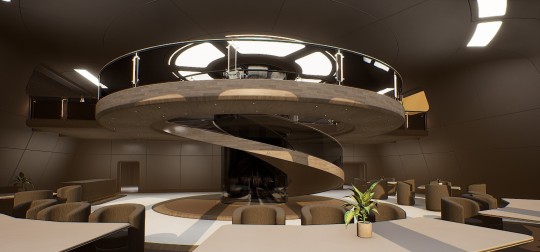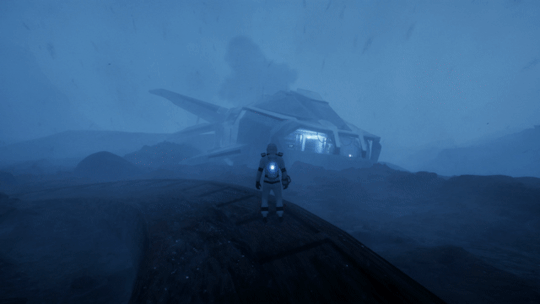#spacegaming
Text
We're working with @composerinprogress for some new trailer music. Here is a small piece of what we have so far.
What do you think? :)
72 notes
·
View notes
Video
A few back-of-the-envelope calculations
What started out as a simple cutscene led me down a rabbit hole of fun facts and figures. Let me explain!
One of the game’s mechanics is travelling between black hole systems in order to find new and progressively harder locations to explore. Naturally, a big theme of this game is the unstoppable passage of time, and the consequences thereof, considering this is how the main character got themselves into this mess to begin with! So of course, I couldn’t pass up the opportunity to remind the player that travelling such large distances between black holes does not happen without consequence. And in a universe running out of it, time is among the most precious of resources!
So when I was adding this small fade in/fade out cutscene to long-distance travel interface, I wanted this to be somewhat reflective of reality. So first, I needed to find an appropriate starting point, and then add on years to this. I first got an estimate of the distance of one of the closest black holes to earth as a starting point (1.5k light years).
Then, I needed to estimate the speed of the ship, in order to calculate travel time. My first thoughts were, well, this game begins during the late 70s/early 80s, what if I just grab the maximum speed of one of the Apollo spacecraft? This put me in the ballpark of ~6667 meters per second or ~0.002% of the speed of light. Then I realised, duh, they could have gone way faster had they not need to slow down and land on the moon!
I then grabbed the Parker solar probe’s top speed and converted that to a % of the speed of light, ~0.064%. Then I took the inverse of it in order to see how long it’d take to travel 1 light year (~1560 years). Finally, I multiplied this value by the close black hole distance I found earlier to get a travel time of ~2.339 million years, give or take some years to account for the initial acceleration and deceleration (which should be comparatively negligible).
Cool, ok so this was my starting point. I realised that it’d be another ~10^50 years before that small black hole evaporated, which is ACTUALLY when your journey starts, but I chose to ignore this and focus on the time the character has been travelling for. If I had started at 10^50 years, you’d never see the numbers tick upward so dramatically!
The in-game travel time calculation was then quite simple. I generously estimated that with highly advanced rockets/energy generation strapped on to your 70s rocket, it would be able to achieve a speed of 1% the speed of light, quite a significant improvement over the solar probe!
So what about the average distance between black holes now? Well, all the smaller ones would have evaporated or been consumed by bigger ones by now, so I began by looking at the average distance between galaxies, which was estimated to be ~1 million light years apart on average. This number varies wildly however, as there are galactic clusters and voids in space rather than an even distribution, so that, plus the expansion of the universe going at full bore, I decided that each black hole system will be randomly 1.00-9.99 million light years apart. That’s roughly in the right ballpark I’d say.
Finally, with all the numbers in place, I do the same calculation in-game, 1% of the speed of light means 100 multiplied by the distance to give you the right amount of human years. Done.
“But wait,” I hear you say, “aren’t you going to lose precision/overflow as the game progresses? And how does the character survive for that long? What about the relativistic effects??”, to which I would reply, stay tuned for part 2 of this blog...
;)
P.S. now that I’ve exposed my terrible terrible math for everyone to see, I’m awaiting the inevitable corrections from you smart, smart people out there, and have prepared this gif in advance:

#game#videogame#devblog#gamedev#scifi#spacegame#dungeon crawler#rpg#entropy#gamemaker#programming#pixel art#robot#indiedev
70 notes
·
View notes
Text

#3dart#indiegames#gamedev#indiegame#indiedev#UnrealEngine5#puzzlegame#scifi#scifiart#gamedesign#spacegame#space#gaming#indie games#indiegameart#game development#gif#flashing gif#animate
10 notes
·
View notes
Text
PUNCHY!

Punchy doing what punchy does best!
13 notes
·
View notes
Text
Frameshift Live #29
twitch_live
Frameshift Live #29
Live EliteDangerous - Twitch
3 notes
·
View notes
Text
two radiant kinds of emotion: saying "huge day for annoying people" about something you dislike vs saying "huge day for annoying people" about something you love dearly
#this is about bg3 and preorder starfield access dropping within 24 hours of each other#ive avoided the bethesda brain viruses for over ten years but ive finally been bitten by spacegame#and i can feel myself transforming into a skyrim guy three months out
4 notes
·
View notes
Photo

#unsettled #boardgame #boardgames #space #spacegame (helyszín: Budapest, Hungary) https://www.instagram.com/p/CoPaMrSo5_la1iUn2DsJiDrfrEZvfXXoHcAqqA0/?igshid=NGJjMDIxMWI=
3 notes
·
View notes
Video
youtube
Orthrus Hunter v2 Ship Build // Solo Orthrus Elite Dangerous
0 notes
Text
Research Efforts for BRP Design Challenge Part 2.
Why space might be the final TTRPG frontier.
Sci-Fi games set in the depths of space is probably one of the hardest genres to break into successfully. There are subgenres to consider. There are huge titles in every subgenre. Here’s a list of space TTRPGs that are intimidating to try to compete with:
Traveler.
Star Trek.
Star Wars.
Star Frontiers/Frontier Space.
Starfinder.
Warhammer…

View On WordPress
#BRP#BRPDesignChallenge#rpgblog#rpgwriter#spacegames#spacerpg#Starfinder#starfrontiers#starfrontiersday#StarTrekRPG#starwarsrpg#starwarsttrpg#ttrpg#TTRPGblog#TTRPGblogger#ttrpgdesign#ttrpgwriter
0 notes
Video
youtube
Eve online quête épique 'Des étoiles tachées de sang' - chapitre 7
#youtube#eveonline#capsuleer#SpaceGame#EveCommunity#mininglife#PvPAdventures#EveExploration#tradinggame#AmarrEmpire#CaldariState#GallenteFederation#MinmatarRepublic#PirateFactions#EveRP#SpaceRoleplay#CapsuleerStories
1 note
·
View note
Text




We've been working hard on the officer's lounge rebuild, and we also have a working lift!
Next is to finish off the external ship and for anyone on the alpha builds, don't get lost
#starsim#starshipsimulator#indiegame#spacegame#spacesim#gaming#pc gaming#video games#gamedev#simulation
20 notes
·
View notes
Photo

Hi
Apologies for the slow posts recently, I’ve had Real Life™ to deal with unfortunately, so I haven’t been as consistent as I would have liked. Nevertheless, it’s a public holiday here so I thought I’d take the time to work on the game some more.
The problem
I had a couple of bugs that I had identified a few days ago regarding the dungeon generation. While the structure of the dungeon (walls, floors, etc) were fine, something was off about the way the dungeon features (gather points, mining points, treasures, stairs) were being generated.
Specifically, features that were defined using a proportion of tiles (say, 0.05 = 5% of the tiles) were not appearing, while the ones defined using a flat number (10 = 10 of the tiles) were working just fine and dandy. I suspected this was initially due to the code I added to make features less prevalent on the earlier floors, a risk/reward thing as the enemy encounters get more difficult the lower you go.
Bugs into bugs
Heading down into the dungeons to get my (virtual) boots dirty, the entry floor was indeed bereft of the aforementioned mining and gathering points. However, I couldn’t check whether features were generating on lower floors (with higher proportions), as I was now getting crashes upon going deeper into the dungeon!
I tracked down the source of this - the appearance of the dungeon wanted to update as the floor had now changed, but it couldn’t find the data structure that contained the tile information. But why could it load the first floor and not subsequent ones???
Well, I had recently reworked which object holds the data structures were located, putting everything now into the data structure manager since it also manages saving and loading of said data structures. I thought I was safe to do this as I had written a wrapper function that always points to the right location of the data structure, so I only had to update it there to propagate changes throughout my code.
That was true, BUT I had some code referencing the data structure location directly (naughty) that I had wrote early on before I realised I should be using these wrapper functions. So it was not finding it, and, when I DID end up using the function, I needed to wait until the next frame to update everything as the “move” between floors hadn’t fully happened yet. Anyway, problem solved.
Some basic math...
So I step into the next floor of the dungeon and, uh, still nothing. No features. Completely bare. So, that confirmed that I was in the right place in the code, where I was determining whether or not a feature should be added to a tile.
The problem turned out to be a subtle distinction in the way I was calculating whether to add a tile or not. I had in my head that I wanted to convert X% of tiles into a certain feature, but my code was actually saying that, each tile had an X% chance of being converted.
Of course, in the long run the two would be absolutely equivalent, but I wanted a guarantee that a certain proportion of tiles would become a certain feature! Once I realised that, it was a relatively easy fix.
Funnily enough, I was able to standardise my code a bit more. Instead of many conditions throughout the code that needed to check whether I had specified a proportion (<1) or a flat number (>=1) and then calculate differently based on that, I simply specified a target feature number early on which either equaled the flat number or was equal to the total tiles * proportion.
Lessons learned
With that fixed, I went back into the dungeon, saw the features were now generating, and to celebrate, I picked up a rock (see image). I was amused that I had written placeholder text for the pickup description (first line), and then I have what you ACTUALLY got from the action (second line). I guess the dungeon didn’t really appreciate my work of populating it properly.
Anyway, the lesson? “X% of tiles” is NOT the same as “convert tiles with an X% chance”. Not with small sample sizes anyway.
#game#videogame#devblog#gamedev#scifi#spacegame#dungeon crawler#rpg#entropy#gamemaker#programming#pixel art#robot#indiedev
28 notes
·
View notes
Text

The Ship and the storm
gif
#3dart#indiegames#gamedev#indiegame#indiedev#UnrealEngine5#puzzlegame#scifi#scifiart#gamedesign#spacegame#space#gaming#indie games#indiegameart#game development#gif#flashing gif#animated
4 notes
·
View notes
Video
youtube
In FTL you experience the atmosphere of running a spaceship trying to save the galaxy. It's a dangerous mission, with every encounter presenting a unique challenge with multiple solutions. What will you do if a heavy missile barrage shuts down your shields? Reroute all power to the engines in an attempt to escape, power up additional weapons to blow your enemy out of the sky, or take the fight to them with a boarding party? This "spaceship simulation roguelike-like" allows you to take your ship and crew on an adventure through a randomly generated galaxy filled with glory and bitter defeat.
1 note
·
View note
Text
Cosmic Conquest: A Stellar Odyssey of Strategy and Unity
What’s your favorite game (card, board, video, etc.)? Why?
As the Epic Alien, traversing the cosmos has introduced me to countless civilizations and their unique forms of entertainment. Among the vast array of games I’ve encountered, one stands out as my favorite—an intergalactic strategy game known as “Cosmic Conquest.”
In “Cosmic Conquest,” players become cosmic leaders, commanding their…

View On WordPress
#CosmicAdventure#CosmicConqueror#CosmicConquest#CosmicGaming#dailyprompt#dailyprompt-2004#EpicAlien#IntergalacticStrategy#SpaceGames
0 notes
Text
On space games and the issues you might come across when developing them
So for a week I decided to try and develop a game where you travel across a universe, just to see if I could even do it in unity(Bear in mind alot of this info comes from a GDC from the kerbal space program developers)
The main issue with computers is that they cannot handle big numbers so you will experience issues while really far away from the center, because of that graphics and physics will jitter alot
The most well known and talked about solution is called Floating origin
where if you’re player moves far enough from the center, It will move the player back. In simple terms the player is always in the center, the universe just moves
But I came across a 2nd issue. The Camera(both editor and in game) have issues rendering at far distances. It was actually really hard to find a planet at sizes this big
Another less known solution is called Scaled Space, something came up by the kerbal space program devs. It works like this: Say you’re on earth and you want to render the other planets in the solar system. So you created a miniature verison of the solar system and put a camera in that. that way it can see really far away. You render that first, and then render the camera on earth over that miniature scale of the universe
While you can find your own scripts on floating points scaled Space was a issue
sense it was only talked about for a brief bit in the GDC talk and I had to make it myself
It was sorta easy at first. have 2 scenes. create a layer for the two and cull each camera to each scene. have a global variable for how scaled down the scaled space should be and copy the camera position(scaled down of course) + rotation
But how do we do the rendering? eventually after experimenting I found the solution. We have the camera in the scaled see render the skybox + scaled down planets. while the camera in the original scene only render to the depth on top of the scaled planets. that way it will render objects on top of the scaled space without the skybox blocking the other planets in scaled space
The biggest issue so far is combining all that(along with other features) together. here’s a video of the current state of the project
youtube
1 note
·
View note